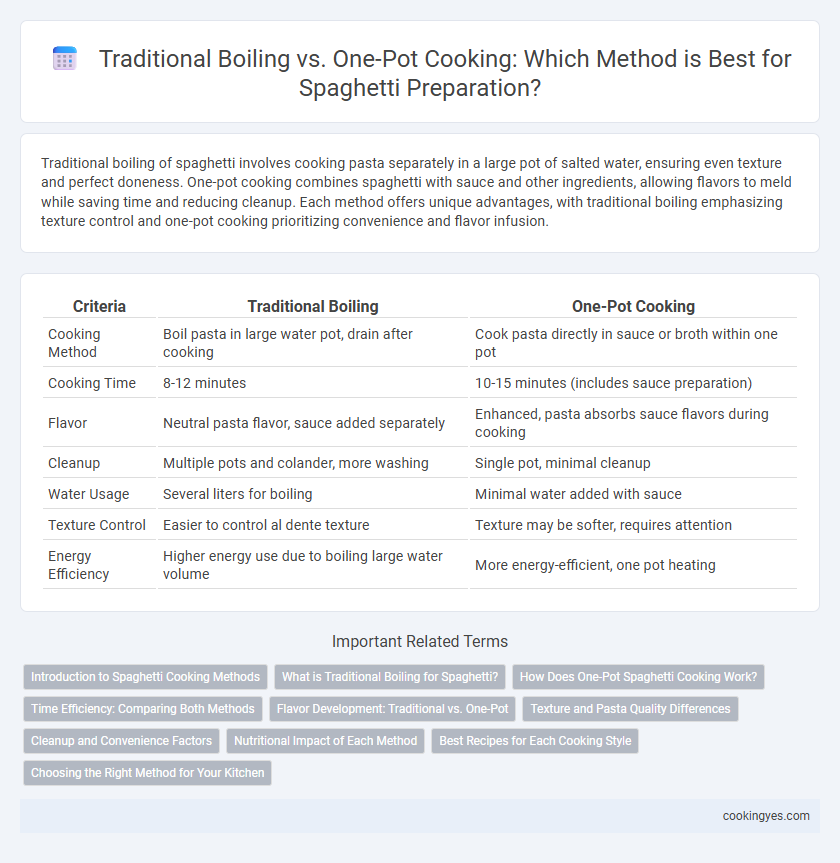Traditional boiling of spaghetti involves cooking pasta separately in a large pot of salted water, ensuring even texture and perfect doneness. One-pot cooking combines spaghetti with sauce and other ingredients, allowing flavors to meld while saving time and reducing cleanup. Each method offers unique advantages, with traditional boiling emphasizing texture control and one-pot cooking prioritizing convenience and flavor infusion.
Table of Comparison
| Criteria | Traditional Boiling | One-Pot Cooking |
|---|---|---|
| Cooking Method | Boil pasta in large water pot, drain after cooking | Cook pasta directly in sauce or broth within one pot |
| Cooking Time | 8-12 minutes | 10-15 minutes (includes sauce preparation) |
| Flavor | Neutral pasta flavor, sauce added separately | Enhanced, pasta absorbs sauce flavors during cooking |
| Cleanup | Multiple pots and colander, more washing | Single pot, minimal cleanup |
| Water Usage | Several liters for boiling | Minimal water added with sauce |
| Texture Control | Easier to control al dente texture | Texture may be softer, requires attention |
| Energy Efficiency | Higher energy use due to boiling large water volume | More energy-efficient, one pot heating |
Introduction to Spaghetti Cooking Methods
Traditional boiling involves cooking spaghetti in a large pot of rapidly boiling water until al dente, ensuring even texture and separation of strands for classic taste. One-pot cooking combines the pasta, sauce ingredients, and water in a single pot, allowing flavors to meld as the spaghetti absorbs the liquid during cooking. This method reduces cleanup and can enhance the depth of flavor by infusing the starches directly into the sauce.
What is Traditional Boiling for Spaghetti?
Traditional boiling for spaghetti involves cooking pasta in a large pot of rapidly boiling salted water until it reaches the desired al dente texture. This method allows for even cooking and prevents the strands from sticking together by stirring occasionally and maintaining a rolling boil. The drained pasta is then typically combined with sauce separately, preserving texture and flavor control.
How Does One-Pot Spaghetti Cooking Work?
One-pot spaghetti cooking involves combining dry pasta, sauce ingredients, and liquid in a single pot, allowing the pasta to cook directly in the sauce as the liquid simmers. This method enables starch from the pasta to thicken the sauce naturally, creating a cohesive and flavorful dish without the need for separate boiling and draining steps. By reducing cleanup and infusing flavors during cooking, one-pot spaghetti offers a convenient and efficient alternative to traditional boiling.
Time Efficiency: Comparing Both Methods
Traditional boiling of spaghetti typically requires separate steps for boiling water and draining pasta, consuming more time overall, often around 10-12 minutes. One-pot cooking combines pasta, water, and sauce in a single pot, reducing preparation and cleanup time to approximately 15 minutes, enhancing time efficiency. This method simplifies the cooking process by allowing simultaneous cooking and flavor infusion, saving valuable kitchen time without compromising taste.
Flavor Development: Traditional vs. One-Pot
Traditional boiling of spaghetti allows for precise control over pasta texture but often results in a less integrated flavor profile as the sauce and pasta cook separately. One-pot cooking infuses the spaghetti with sauce flavors during the cooking process, enhancing taste complexity through simultaneous absorption and reduction. This method promotes deeper flavor development by allowing starches released from the pasta to naturally thicken the sauce, creating a richer and more cohesive dish.
Texture and Pasta Quality Differences
Traditional boiling of spaghetti in a large pot of salted water ensures even cooking and a firm al dente texture, as the pasta has ample space to move freely. One-pot cooking, where spaghetti is cooked directly with sauce or in minimal water, often results in a softer texture and slightly stickier pasta due to starch release and reduced water volume. The choice between methods significantly impacts the final texture and pasta quality, with traditional boiling favoring firmness and one-pot cooking offering convenience but softer consistency.
Cleanup and Convenience Factors
Traditional boiling of spaghetti requires a large pot and a separate colander, resulting in more dishes to clean and greater water usage. One-pot cooking combines the spaghetti and sauce ingredients in a single pan, significantly reducing cleanup time and conserving kitchen resources. This method enhances convenience by minimizing utensil use and simplifying the cooking process without sacrificing flavor.
Nutritional Impact of Each Method
Traditional boiling of spaghetti in ample water preserves most nutrients but can lead to slight loss of water-soluble vitamins like B-complex and folate due to leaching. One-pot cooking retains more nutrients by absorbing the cooking water, including starches and minerals, into the pasta, enhancing the overall nutritional value. Incorporating sauce ingredients directly in one-pot recipes further enriches the dish with antioxidants and vitamins often lost in traditional draining methods.
Best Recipes for Each Cooking Style
Traditional boiling ensures al dente spaghetti with separate strands by boiling in ample salted water, ideal for classic recipes like spaghetti aglio e olio or carbonara. One-pot cooking integrates pasta, sauce, and ingredients in a single pot, absorbing flavors deeply in dishes such as one-pot spaghetti bolognese or tomato basil spaghetti. Each method maximizes texture and taste, catering to either precise control or convenience without compromising on authentic Italian flavors.
Choosing the Right Method for Your Kitchen
Traditional boiling for spaghetti ensures precise control of texture and flavor by cooking pasta separately in ample salted water, which minimizes starch buildup and results in perfectly al dente strands. One-pot cooking combines pasta, sauce, and ingredients in a single pan, saving time and reducing cleanup while allowing pasta to absorb flavors directly from the sauce. Selecting the right method depends on your kitchen setup, time constraints, and desired flavor intensity, with traditional boiling favored for culinary precision and one-pot preferred for convenience and efficiency.
Traditional boiling vs One-pot cooking for spaghetti preparation Infographic

 cookingyes.com
cookingyes.com